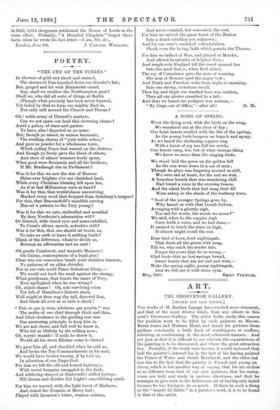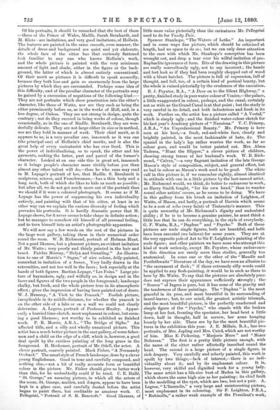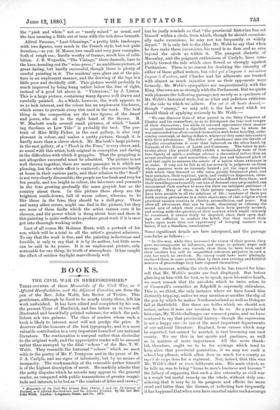ART.
THE GROSVENOR GALLERY.
[SECOND AND LAST NOTICE.]
THE works of M. Bastian Lepage have excited more comment, and that of the most diverse kinds, than any others in this year's Grosvenor Gallery. The artist holds easily this season the position wont to be filled by such painters as Messrs. Barne Jones and Holman Hunt, and round his pictures there gathers constantly a little knot of worshippers or scoffers, admiring or condemning in the most vehement manner. And yet just at first it is difficult to see wherein the separateness of the painting is to be discovered, and where the great attraction lies. Probably, if the truth were known, it would be found that half the painter's interest lay in the fact of his having painted. the Prince of Wales and Sarah Bernhardt, and the other hal was due to the fact that the painter is French and young an clever, which is but another way of saying that his art strikes us as different from that of our own painters, that his endea- vours are bold and made in various directions, and that he manages to give even to his failures an air of having only failed because he was trying to do so much. If there be such a thing as the " beaute du diable " in a painter's work, it is to be found. in that of this artist.
Of his portraits, it should be remarked that the best of them —those of the Prince of Wales, Madlle. Sarah Bernhardt, and M. Klots—are imitations, and very good imitations, of Holbein. The features are painted in the same smooth, even manner, the details of dress and background are quiet and yet elaborate, the whole face of the sitter has that curiously flattened look familiar to any one who knows Holbein's work, and the whole picture is painted with the very minimum amount of light and shade, either in the figure or the back- ground, the latter of which is almost entirely conventional. Of their merit as pictures it is difficult to speak assuredly, because they both lose and gain so enormously from the large pictures by which they are surrounded. Perhaps some idea of this difficulty, and of the peculiar character of the portraits may be gained by a succession of negations of the following kind :- They are not portraits which show penetration into the sitter's character, like those of Watts, nor are they such as bring the sitter prominently before us, as in the works of loll, and, in a less degree, of Ouless. They are not strong in design, quite the contrary ; nor do they succeed in being works of colour, though occasionally, as in the one of Madlle. Bernhardt, they are won- derfully delicate. They are not large either in size or in method, nor are they bold in manner of work. Their chief merit, as it appears to us, is a very peculiar one, inasmuch as it was one (the principal one) of Holbein's chief merits, and is also the great help of every caricaturist who has ever lived. This is the power of individualising, so to speak, the sitter and his garments, making the latter, part and parcel of the former's character. Looked at on one side this is great art, inasmuch as it brings people's character more vividly before you than almost any other talent will do,—thus he who runs may read in M. Lepage's portrait of her, that Madlle. S. Bernhardt is sculptress, actress, and Frenchwoman,—has a thin body and a long neck, both of which she likes to hide as much as possible; but after all, we do not get much more out of the portrait than should if it were a coloured photograph. It seems as if M. Lepage has the power of suppressing his own individuality entirely, and painting with that of his sitter, at least in no other way can we explain the curious diversity of feeling which pervades his portraits. It is hardly dramatic power that M. Lepage shows, for it never seems to take shape in definite action ; but he manages to somehow rid himself of all personal feeling, and to turn himself into an artist's photographic apparatus.
We will now say a few words on the rest of the pictures in the large west gallery, taking them in their numerical order round the room. W. B. Richmond, portrait of Holman Hunt. Not a good likeness, but a pleasant picture, an evident imitation of Mr. Watts ; very poorly and thinly painted in the hair and beard. Fairfax Murray, " Helya and Gunnling." An illustra- tion to one of Morris's "Sagas," of nice colour, drily-painted, somewhat in imitation of a fresco.. Very badly drawn in the extremities, and not too well in the faces ; look especially at the hands of both figures. Bastian Lepage, "Les Foins." Large pic- ture of haymakers, ugly, and wilfully so, in design and in the faces and figures of the two people in the foreground; landscape chalky, but fresh, and the whole picture true in its atmospheric effect; gives the impression of having been painted out of doors. W. J. Henessy, "A Visit to the Peacock." Foolish picture, inexplicable in its middle-distance, for whether the peacock is on the other side of a lake or on a wall we could not clearly determine. A. Legros, portrait of Professor Huxley. Appar- ently a hurried time-sketch, most unpleasant in colour, but seem- ing a good likeness ; not worthy to be exhibited as finished work. P. R. Morris, A.R.A., "The Bridge of Sighs." An affected title, and a silly and wholly unnatural picture. This artist has a much better picture in the east gallery, of some fisher- men and a child on the edge of a cliff, which is, however, a good deal spoilt by the careless painting of the long grass in the foreground. H. Herkomer, portrait of Mr. Odell, the actor. A clever portrait, coarsely painted. Mark Fisher, "A Normandy Orchard." The usual style of French landscape, done by a clever young Englishman. Good in tone and carefully composed, and nothing else,—not a bit of really accurate form or beautiful colour in the picture. Mr. Fisher should give us better work than this, for he undoubtedly could if he tried. C. E. Ha114, "St. George," an amazing picture, in which all the actors of the scene, St. George, maiden, and dragon, appear to have been kept in a glass ease, and carefully dusted before the artist began to paint them, but creditable as amateur work. C. Pellegrini, "Portrait of S. 'B. Bancroft." Good likeness, of little more value pictorially than the caricatures Mr. Pellegrini used to do for Vanity Fair.
Spencer Stanhope, "The Waters of Lethe." An important and in some ways fine picture, which should be criticised at length, had we space to do so ; but we can only draw attention to the care with which Mr. Stan]]ope's conception has been wrought out, and drop a tear over his wilful imitation of pre- Raphaelite ignorance of form. Bits of the drawing in this picture are really marvellously ugly, not to say incorrect ; the hands and feet look as if they had been roughly chopped out of wood with a blunt hatchet. The picture is full of expression, full of thought, and full, too, of a certain kind of poetical beauty, but the whole is ruined pictorially by the crudeness of the execution.
E. J. Poynter, R.A., "A Door on to the Silent Highway," a pretty, finished study in pure water-colour of Venice,—the palace, a little exaggerated in colour, perhaps, and the canal, certainly not as wide as the Grand Canal is at that point ; but the study is very careful in its detail, and both industrious and fresh in its work. Further on, the artist has a picture called "A Vestal,' which is simply ugly ; and the finished water-colour sketch for. his last year's Academy picture of " Nansicaa." V. C. Prinsep, A.R.A., "An Unprofessional Beauty?' Mr. Prinsep is here- seen at his best,—a fresh, red-and-white face, clearly and brightly painted, in the most fashionable of hate, &c. The. spaniel in the lady's lap rather worries the work, as far as- colour goes, and would be better painted out. Mrs. Alma Tadema, "Hunt the Slipper," a clever picture of children,. showing strong traces of her husband's work. W. B. Rich- mond, " Calves,"—a very flagrant imitation of the late George- Mason's style of composition, subject, and general effect, but- as bad in colour as Mason's work used to be good. The white- calf in this picture is, if we remember rightly, almost identical in attitude with one in a little picture by the last-named artist- Mr. Richmond would, we think, do better to endeavour to work,. as Harry Smith fought, "for his own hand," than to wander round other artists' covers, as he seems to be doing. We have- in this gallery from his brush an imitation of Leighton,.of Watts, of Mason, and lastly, a portrait of Darwin which seems. to be a sort of echo (very faint) of Tintoretto's manner. This is quite unworthy of Mr. Richmond's dignity and undoubted' ability ; if he is to become a genuine painter, he must think a, little less that he can do everything, in the style of everybody- G. F. Watts, R.A., " Daphne " and "Psyche." Both of these' pictures are nude single figures, both are beautiful, and both, have been executed (we believe) for some years. They are at. the very opposite pole of Art to Sir F. Leighton's painting of the nude figure; and other painters we have none who attempt this kind of work seriously, except Mr. Poynter, whose endeavours. in this direction are rarely more than studies, generally too anatomical. In some one or the other of the " Maudle and Postlethwaite " literature of the day, we have seen an allusion to. "the sacrament of flesh ; " if those extremely silly words could be applied to any flesh-painting, it would be to such as there is here by Mr. Watts. To say that the pictures are absolutely pure' does not express their appearance sufficiently strongly ; the. " Source " of Ingres is pure, but it has none of the gravity and the tenderness of these paintings. The " Daphne " is the most graceful in its pose, and most beautiful in its surrounding, of laurel-leaves ; but, to our mind, the greatest artistic triumph, and the most beautiful picture, is the perfectly unadorned and simple figure of the "Psyche," who stands with the broken lamp at her feet, fronting the spectator, her head bent a little- down, half in thought, half in sorrow, her arms hanging loosely by her side. These are by far the most beautiful pic- tures in the exhibition this year. J. E. Millais, R.A., has two. portraits, of Mrs. Jopling and Mrs. Caird, which are not worthy of him. Miss E. Pickering, "Marjorie Mire" and "Mater Dolorosa." The first is a pretty little picture enough, with the name of the sitter rather affectedly inscribed round the head. The second is a large picture of a single figure, in rich drapery. Very carefully and soberly painted, this work is spoilt by two things,—lack of interest,—there is no indi- viduality about it; and by its unpleasant colour. It is,. however, very skilful and dignified work for a young lady. The same artist has a life-size bust of Medea in this gallery, which shows the same high aim as her painting; its chief fault is the modelling of the eyeb, which are two, but not a pair. A. Legros, " L'Incendie," a very large and uninteresting picture, most unpleasant in its colouring. Sir F. Leighton, P.R.A., " Rnbinella," a rather weak example of the President's work,
the "pink and white" not so "rarely mixed" as usual, and the face seeming a little out of tune with the rich dress beneath.
Alfred Parsons, "Last Gleanings," a pretty little landscape, with two figures, very much in the French style, but not quite formless,—as yet. H. Moore, two small and very poor examples, both of rough sea; hardly worthy of frames, much less of exhi- bition. J. R. Wegnelin, "The Vintage," three damsels, bare to the knee, treading out the" wine-press ;" an ambitious picture, of great daring, but hardly successful, though there is plenty of careful painting in it. The maidens' eyes glare out of the pic- ture in an unpleasant manner, and the drawing of the legs is a little poor and decidedly stiff. This picture would probably be much improved by being hung rather below the line of sight, instead of a good bit above it. "Victorious," by J. Linton. This is a large picture, containing Many figures well drawn and carefully painted. As a vhole, however, the work appears to us to lack interest, and the colour has an unpleasant blackness, which seems to pervade every tint used in the work. The best thing in the composition are the two figures of the dwarf and jester, who sit to the right hand of the throne. R. W. Macbeth sends several small pictures, of which "Land- ing Sardines at Low Tide" is probably the best. The por- trait of Miss Milly Fisher, in the east gallery, is also very pleasant in colour, and makes a pretty picture, though it is hardly more than a clever sketch. Mr. Macbeth's large picture, in the east gallery, of a "Flood in the Fens," is very clever, and, as usual with this artist, both original in conception and daring in the difficulties with which it grapples. That the grappling is not altogether successful must be admitted. The picture is not well thrown together, there are many passages in it which are pleasing, but the whole effect is scattered ; the actors are hardly at home in their various parts, and their relation to the " flood" is not very clearly discernible; the people are too fresh and rosy for fen people, and too bright in colour, the labourers and peasants in the fens growing gradually the same greyish hue as the country about them. In this picture these sheep are the brightest south-downs, full of warm colour, whereas, to be like those in the fens, they should be a dull-grey. These and many other errors, might one find in the picture, but they are none of them faults which the artist cannot cure if he chooses, and the power which is flung about here and there in this painting is quite sufficient to produce great work if it is once got into thorough working order.
Last of all comes Mr. Holman Hunt with a portrait of his son, which will be a trial to all the artist's greatest admirers. To say that the work is fine, and the painting industrious and forcible, is only to say that it is by its author, but little more can be said in its praise. It is an unpleasant picture, only noticeable for one thing, its truth of atmosphere. It has caught the effect of outdoor daylight marvellously well.




































 Previous page
Previous page